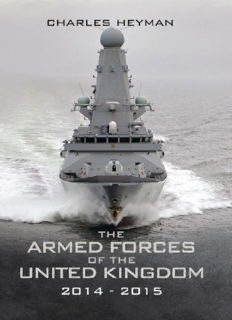Table Of ContentT H E A R M E D F O R C E S
O F T H E U N I T E D
K I N G D O M
2 0 1 4 – 2 0 1 5
Editor – Charles Heyman ISBN 978 1 78346 351 0
Price £9.99
Pen & Sword Books Ltd
47 Church Street
Barnsley S70 2AS
Telephone: 01226-734222 Fax: 01226-734438
www.pen-and-sword.co.uk
The Information in this publication has been gathered from
unclassified sources.
Front Cover: Type 45 Destroyer HMS Diamond on sea trials before joining
the Fleet. (MoD Crown Copyright 2013) Rear Cover: RAF Regiment Forward
Air Controllers guide a Typhoon from
6 Squadron RAF onto a land target during training in Scotland. (MoD Crown
Copyright 2013)
CONTENTS
Chapter 1 – The Management of Defence
General Information
Government
Military Tasks
Defence Planning Assumptions
Future Force 2020
Total British Armed Forces
Current Force Levels
Ministry of Defence (MoD)
Defence Committees
MoD Head Office
Chief of The Defence Staff
Vice Chief of the Defence Staff
Chain of Command
Defence Equipment and Support
Staff Branches
NATO Overview
SACEUR – General Breedlove
NATO Commands
The 2003 NATO concept
NATO Readiness Forces
The Allied Rapid Reaction Corps
European Union (EU)
European Union Military Staff
EUMS Outline Structure
EU Military Operations
European Defence Agency
Eurocorps
Franco - German Brigade
EU Battlegroups
EU Relationship with NATO
Anglo – French Collaboration
European Rapid Reaction Force
Afghanistan (Operation HERRICK)
Afghanistan ISAF
Afghanistan – Costs
The Finances of Defence
UK Defence Expenditure
NATO Budget Comparison
UK MoD Personnel Figures
Chapter 2 – The Royal Navy
Personnel Summary (mid 2013)
Fleet Strength Overview
Composition of the Fleet
Higher Management
Chief of the Naval Staff
Logistic Support
Major Naval Bases
Shore Establishments
Royal Naval Reserve Units
Principal Warships
Strategic Deterrent
Trident Successor Programme
Fleet Submarines
Trafalgar Class
Astute Class
Surface Fleet
Assault Ships
Albion Class (LPD)
Ocean (LPH)
Illustrious
Destroyers
Type 45 - Daring Class.
Frigates
Outline Organisation of a Frigate
Type 23 (Duke Class)
Future Surface Combatant
The Future Carrier Strike Capability
F-35B (Lightning II)
Response Force Task Group
Warfare Training Facility
Mine Counter Measures
Hunt Class
Sandown Class
Replacement MCM Vessels
Antarctic Patrol Ships
Endurance
HMS Protector
Survey Ships
Patrol Vessels
Ships names
Royal Fleet Auxiliary Service
Tankers
Fleet Replenishment Ships
Landing Ships
Miscellaneous RFA Vessels
MARS Project
Harbour Services
Fleet Air Arm
Naval Aircraft
Naval Air Squadrons
Joint Helicopter Command
Naval Aircraft
Sea King
EH101 Merlin HM Mk1
Lynx
Wildcat (AW159)
Naval Missiles
SLCM: Hughes Tomahawk
Harpoon
Sea Viper (PAAMS - Aster)
Sea Wolf
Sea Skua
Future Guided Weapons
Sea Ceptor
The Royal Marines
3 Cdo Bde Commando Organisation
Commando Organisation
43 Commando
1 Assault Group
Special Boat Service
Royal Marines Reserve (RMR)
Chapter 3 – The British Army
Personnel Summary (mid 2013)
British Army Statistics
Formations
British Army Equipment Summary
Higher Management of the Army
The Army Board
Chief of the General Staff
Chain of Command
Army Headquarters (Army HQ)
Commander Land Forces (CLF)
3 (UK) Division
1 (UK) Division
Force Troops
London District
Joint Helicopter Command (JHC)
Armoured Brigade
16 Air Assault Brigade
Light Brigade - 1 (UK) Division
Logistics Brigades
The Battlegroup
Units of the Army
Armour
Armoured Unit Locations
Armoured Organisations
The Infantry
Infantry Organisations
Infantry Locations
Army Air Corps
The Royal Regiment of Artillery
Corps of Royal Engineers
The Royal Corps of Signals
The Royal Logistic Corps
REME
Army Medical Services
The Adjutant General’s Corps
Smaller Corps
Army Reserves
The Regular Army Reserve
Army Cadets
Challenger 2
Fv 107 Scimitar
Panther CLV
Jackal 1/2 (4 × 4 Patrol Vehicle)
Coyote
MCV - 80 Fv 510 (Warrior)
Mastiff 2 (FPV)
AFV 432 and Bulldog
Foxhound
AS 90
227 mm GMLRS
105 mm Light Gun
Starstreak HVM
Rapier (FSC)
Apache (AH Mk1)
Wildcat (AW159)
Javelin LF ATGW
5.56 mm Individual Weapon
5.56mm Light Machine Gun
7.62 mm (GPMG)
60 mm Light Mortar
Chapter 4 – The Royal Air Force
Personnel Summary
RAF Aircraft in Service
Royal Air Force Squadrons
RAF Squadron Listing
British Commercial Aviation
Higher Management
Air Force Board
Chief of The Air Staff
HQ Air Command
No 1 Group
No 2 Group
No 22 (Training) Group
Flying Training Overview
Joint Helicopter Command
UK Air Surveillance (ASACS)
RAF Communications
Logistic Support
RAF Station Organisation
Overseas Bases
Tornado GR-4
Typhoon FGR4
F-35B Lightning
Predator MR-9 Reaper
Taranis
E-3D Sentry AEW1
Sentinel R1 (ASTOR)
Hawk T1/T1A/T2
Hawk T2
Tucano
C-130 Hercules
C-130J C4/C5 Hercules
C-17 Globemaster
A400M Atlas (FLA)
Air-to-Air Refuelling (AAR)
Voyager (FSTA)
Chinook HC4/HC4A/HC5
Puma HC2
Merlin HC3
Sea King HAR3/3A
Air to Air Missiles
Sidewinder AIM-9L
ASRAAM
AMRAAM
Meteor (BVRAAM)
Storm Shadow
ALARM
Brimstone
Paveway II
Paveway III
Enhanced Paveway
Paveway IV
Freefall bombs
CVR-7 Rocket
Ballistic Missile Defence
RAF Regiment
Squadrons & Wings
RAF Reserves
Royal Auxiliary Air Force
Chapter 5 – Joint Forces and Joint Service
Joint Forces Command
Chief of Joint Operations
JFC Structure
Permanent Joint Headquarters
Chain of Command for Joint Ops
Joint Rapid Reaction Force
Joint Force Logistics
Special Forces
Special Forces Support Group
Special Reconnaissance Regiment
18 (UKSF) Signal Regiment
Special Forces Reserve
Joint Helicopter Command
Defence Medical Services
Defence Nursing Staff
Hospital Care
Centre for Defence Medicine
Defence Equipment and Support
Defence Infrastructure Organisation
Joint CBRN Defence
Joint Services Signal Organisation
Skynet
Ministry of Defence Police
Ministry of Defence Guard Service
Military Corrective Training Centre
Chapter 6 – Miscellaneous
The Services Hierarchy
UK Armed Forces Pay
The Mod’s Civilian Staff
The UK Defence Industry
QinetiQ
The MoD’s Land Holdings
Codewords and Nicknames
Dates and Timings
Phonetic Alphabet
Op Banner - Northern Ireland
Fatal Casualties since 1945
Quotations
Abbreviations
Charles Heyman (Editor)
Publishing Detail
Description:This book has been published at regular intervals during the last 20 years, and the latest 2014 – 2015 addition is the one that deals with the most far reaching changes the UK Armed Forces have gone through for a generation. Although the UK’s Armed Forces are reduced in size, the UK remains the

